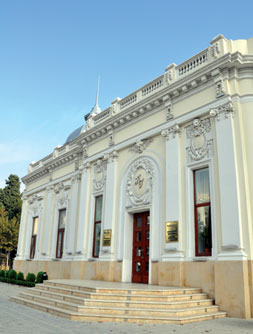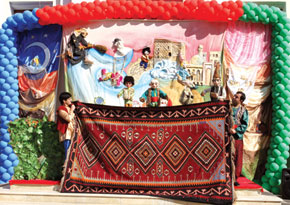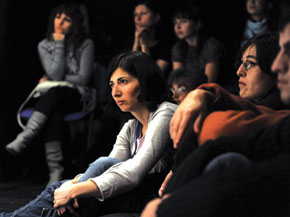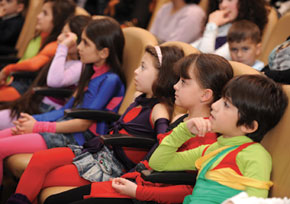 Pages 98-102
Pages 98-102By Aydin Talibzadeh
Children perceive the world through fairy tales, they grow up little by little on these tales. There is nothing conditional, fictional or false for them: everything is true, real; as real as the sea, ships sailing on the sea, as real as the earth and the trees growing in it. There is a fine line between reality and fantasy, fantasy and reality, in such tales.
Fairy tales are a nation’s childhood. Every country is mirrored and senses its cultural identity in these stories. Mothers hand on this identity card to their children. If you want to discover a nation for yourself, observe its traditions, learn its language and then read its tales.
The Baku International Puppet Festival also had its origins in tales. It began with the heroes of both folklore and authored stories: Jirtdan, Malikmammad, Phoenix (in Azerbaijani - Simurg), the beautiful, long-haired Tik-Tik khanim, and other characters from world-famous yarns... On 1 November 2011, we had a wonderful opening ceremony before the Abdulla Shaig Puppet Theatre (named after a well-known Azerbaijani taleteller). Puppet characters from legends local and foreign paced the square in twos and in threes. There was a display of bright costumes and large, gaily-painted statues of some of the characters. Puppets and people mingled. Journalists and cameramen perched here and there with their cameras and microphones. All were genuinely happy; some taking photos with the puppets and others dancing. The festival’s foreign guests were delighted to be in Baku; they were in puppet heaven... The sun was shining, smiling down on the participants... even God was saying Amen! to the opening ceremony of the Baku International Puppet Festival.
Truly international
The initial significance of this event was its opening on the eve of the 80th anniversary of the Azerbaijan State Puppet Theatre. The second significant feature was, undoubtedly, the staging of such a large-scale international festival for the first time in the history of Azerbaijani theatre. Thirdly, the Baku International Puppet festival was seen by the organizers as not just a festival, but an event directed towards the future of the country’s theatre culture. Thus the Ministry of Culture and Tourism invited guests engaged in contemporary theatre. Who were these people? Jacques Trudeau (France), General Secretary of the International Puppetry Union (UNIMA); Stanislav Doubrava (Czech Republic) UNIMA Vice-President; Ms. Yvette Hardie (South Africa) the president of the International Association of Theatre for Children and Young People – ASSITEJ; Michel Vaïs (Canada) Secretary General of the International Association of Theatre Critics; Tobias Biancone General Secretary of the International Theatre Institute; Movlut Ozjan UNIMA representative in Turkey; Mohammed Al-Afkham (United Arab Emirates) Secretary of the International Theatre Institute; Ibrahim Assiri (Saudi Arabia) Middle East Coordinator, International Theatre Institute; Levan Khetaguri (Georgia) the rector of the Arts Research Institute of Ilia State University.
This list indicates the country’s progress towards the most famous world theatre organizations. It heralds Azerbaijan’s entrance into the community of world theatre. It means becoming known beyond the boundaries of the diaspora, it means dialogue, it means exchange and the advance of cultural policy into the theatre world.
With the opening ceremony complete, it was on to the festival’s opening performance: White and Black, by the Azerbaijan State Puppet Theatre. The little hero of the play took children and adults by the hand and led them into the night of an emerald city full of tales; he showed them funny, prankish dwarves, a good sandman and beautiful babies in the strange shadows in the Baku theatre.
The oldest spectacle
We were next introduced to Uzbekistan’s Khorezm regional puppet theatre and their performance of The Lezghin from Khiva at the Russian Drama Theatre. The story is based on motifs from Uzbek fairy tales and combines ethnic traditions, dances and music: a display of Khiva Lezghin culture. It is built around a dialogue between two Lezghin characters as masters of ceremonies and has the traditional motifs of Soviet national puppet theatres of the past century. The actors, however, were highly impulsive and in positive mood: they performed with great joie de vivre and fanfare. To tell the truth, this was necessary to the performance: the aim was to appeal through the exotic rather than through puppet dynamics. A pleasing performance I was right in believing that this would be the oldest spectacle in the festival!
I could not fit in the third performance of the day, Good and Evil, based on part of Nizami Ganjavi’s Seven Beauties. The theme was well-suited to the festival’s premise: the art of puppetry has always summoned audiences to the side of the good. The puppets are innocent, sinless, pure and neat, funny and sad, mischievous and modest: they carry virtue to the world on their graceful shoulders.
The festival was for adults as well as for children; evening shows were provided for the older aficionados of the art. I do not say shows in vain. The fourth performance of the day was a show - with live music and a mix of silent movie, cartoon, shadow and puppet theatre, it was a magical evening at the Puppet Theatre. The Paper Cinema puppet theatre had arrived at the festival from the UK with three of Edgar Allan Poe’s stories made into three short films with paper pictures and projector. The puppeteers manipulated the paper pictures in front of the lamp so that 3D images appeared on the screen, providing perspective, rhythm and a dynamic visual story. The three visual stories were based on a pattern of thought. However, the magic of the technique used to produce a simple form of performance outshone the idea, the action and even the thread of thought; it was a most attractive way of creating a certain mood and atmosphere.
I thought this had the most imaginative technique of the shadow plays.
Puppet symposium
The International Symposium The Puppetry World of East and West: Idea, Formation, Technique on 2 November that was part of the festival, should be assessed as free, active information exchange. In fact, the symposium considered a range of topics related to the puppet theatre. It was very effective, with speeches by Jacques Trudeau, Stanislav Doubrava and Yvette Hardie. This writer also offered a presentation.
Let us return to the mainstream of the festival and meet the Gong Theatre for Children and Youth from Sibiu, Romania, on the stage of the Russian Drama Theatre. Because I was delayed at the Symposium, I could not watch the morning’s performance of Tiger Cub Petrik (Poltava, Ukraine). But the Gong Theatre’s performance surprised when they presented a marionette performance called Honey, Sugar and Salt as a Romanian story, although there were clear similarities with Shakespeare’s King Lear. One day the king asks his daughters... Is there need to continue? The only difference was that after the youngest states that she loves her father as she does salt, and is turned out of the country, she meets a handsome prince, falls in love with him and lives happily ever after. To tell the truth, this performance was less engaging and technically quite stiff; without scenery or music, it came across as somewhat basic.
Child’s-eye view
The evening session on 2 November brought us Thoughtless by the Playground puppet theatre from Spain. This was a short show on the small stage of the Theatre of Young Spectators and was based on the aesthetics of the black box.
This very visual story was told with a child’s heart and a child’s spirit, but about adults. This spirit was embodied in a child’s possessions, which were the main characters in the performance. The puppeteer entered the stage with a large box and played like a child. He put a long white sock on his hand, poked his first and middle fingers through holes in it, took out a pair of little shoes like thimbles, put them on his fingers and began the play, which was a visual presentation of a story. Love takes a young woman to heaven. But life without love means an emptiness of dreams and a falling from the sky; it means injury and frustration with the ordinariness of life. The puppeteer manipulated his fingers as if they were a puppet and used chalk to draw on the floor of the stage the life line of a woman falling from her dreams. He shuffles her through the city’s sewers and takes her to a broad asphalt street with many cars. So, this is a new stage in her life. The musical accompaniment helped the audience to understand the meaning of the puppeteer’s pictures.
Thoughtless is a show made up of short stories. Fantasy and reality are interwoven; ordinary objects are combined with unusual visual projections in this puppet game. Using finger puppetry, the puppeteer also exploits shadow theatre, object theatre, digital art and remains faithful to his theatre’s creed: To assign new meaning to small things by a creative approach.
This performance was, for me, the most successful play of the festival!
On 3 November I was only able to see one play: the Budrugana Theatre, from Gagra in Georgia performed What a Nice Day, a play without puppets or actors; they used only hands, projector and a screen – it was shadow theatre. The miraculously flexible hands of the actors gave life to the shadows and turned them into cartoons. These hands became a tree, the wind, the moon, a lakelet; they moved like a bear, they swam.
This was certainly the most miraculous shadow performance of the festival.
I had to choose, the next day, between simultaneous performances and went for the Figure Puppet Theatre from Vienna. The marionette manipulation was masterful and there was a wonderful synergy of marionettes and shadows as the former painted pictures, played the piano and skateboarded – all the while their actions being projected onto screens as if they were decorated eggs.
This was the most skilful acting in the festival!
Unfortunately, choosing this performance meant that I missed Mashadi Ibad by Rauf Afshar, our compatriot working in Tallinn, Estonia.
Sounding the depths
The following day saw the Lele Puppet Theatre (Vilnius, Lithuania) on stage performing Music Box (V. Odoevskiy´s Box with a Secret) which presented a view of the child and family relations. This was a highly intellectual show. The actors brought three boxes onto the stage. Was that a snuffbox? As these boxes opened, they turned into puppets (Father, Mother and Child). Their heads were human, as were their feet: but, their bodies were machinery. The Father was a typewriter, Mother was a sewing machine. Their only communication was in quarrelling as each was preoccupied with his or her work and loved only his/her occupation. The Child just turned the wheels of his bicycle next to them. Perhaps the child could bring back the love that had flown with the help of the music box?!
This was also a ‘black box’ performance: the actors in black on a dark stage, with heavy music and problematic subject. The atmosphere was a little oppressive and the action a little static.
Anyway, I remembered “The Music Box” as the deepest play of the festival!
On the last day we watched the Georgian Multi-Pulti World Puppet Theatre (Tbilisi) present Tsikara, a Georgian folk tale for children.
The set revolved around a fir tree, adding rhythm and a dynamic to the puppets’ movements. Tsikara the bull helps his orphan friend to escape his step mother and is ready even to sacrifice his life for the boy. But there is no final tragedy and it was an interestingly, energetic fairy tale for children.
I think that “Tsikara” was the best performance for children.
Azerbaijan´s Gah State Puppet Theatre performed its celebrated show Repka at the Abdulla Shaig Puppet Theatre. This play is a wonderful combination of pantomime, wooden puppets and marionettes but there were some technical problems with this performance, which prevented it reaching its full potential.
Fun finale
The festival’s final performance was Wild Geese by the Ekiyat State Puppet Theatre (Kazan, Tatarstan). This was an event on a grand scale, played at lightning speed on a grassy set. The actors were actually more expressive than the puppets: they sang, danced and organized a small Sobuntay (Tatar national holiday). The children in the audience applauded with great joy and enthusiasm….This was the perfect way to end a festival which had also featured puppeteers from Egypt, Iran, Turkey. Kazakhstan, Estonia and Astrakhan.
It is always a great occasion when puppets are seen in the streets or onstage; it is an occasion not only for children but also for adults. The main purpose of the Baku International Puppet Festival was once again to bring a grand occasion to Azerbaijan, to provide a festive mood and a smile, to take the whole city back to the world of childhood and to turn Baku into the emerald city of the fairy tale. And I think we achieved that!
All performances bar one sold out; extra chairs and benches had to be commandeered and there were even people on the floor and stairs.
On the other hand, the Festival aimed to spread artistic and aesthetic trends important to modern puppet theatre, to discuss the areas of interest and priorities for the contemporary world of puppetry, to establish a wide network for contact between puppeteers, and to organize exchanges of experience. Time will tell how far we succeeded...
But I would already make the claim that this exciting event switched on a green light for Azerbaijani theatre to enter the world of theatre in many different countries.
The First Baku International Puppet Festival was organized by the Azerbaijan Ministry of Culture and Tourism with assistance from TURKSOY and UNIMA, and was a true fairy tale.
See you at the next one!





